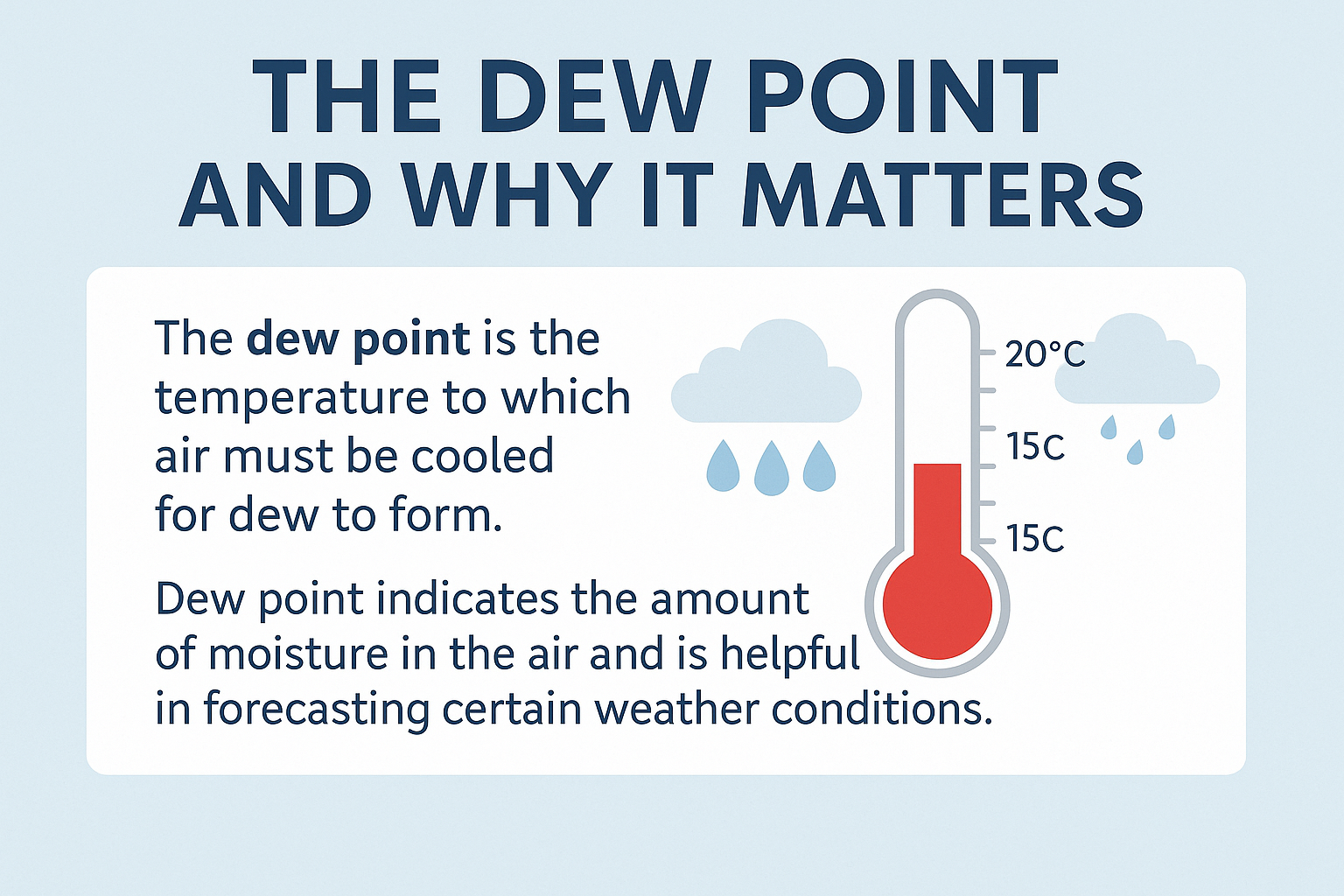The dew point is one of those weather terms you hear thrown around a lot, especially in summer forecasts or when there’s a misty morning outside.
But it’s not just a fancy way of saying “it’s a bit muggy.” The dew point is a specific, measurable temperature — and it’s actually more useful than humidity when it comes to understanding how the air feels and what kind of weather is brewing.
So, what exactly is Dew Point?
The dew point is the temperature to which air needs to be cooled, at constant pressure, for dew to form. That means it’s the point where the air is fully saturated with water vapour.
Any further cooling and the moisture has to go somewhere — it condenses. That might mean droplets on your car windscreen, a foggy morning, or the start of a thunderstorm if the conditions are right.
Let’s put it another way. If the air temperature and the dew point are the same, the air can’t hold any more moisture, and you’re likely to get condensation.
If they’re very close together — say a temperature of 15°C and a dew point of 14°C — the air feels heavy, damp, and very humid. But if the temperature is 15°C and the dew point is down at 4°C, the air feels much drier and crisper.
Why does it matter to forecasters, though?
Well, the dew point tells you more about how much actual moisture is in the air than the relative humidity does. Humidity is a percentage and changes depending on the air temperature.
Dew point, on the other hand, is an absolute value — it doesn’t change unless the amount of moisture in the air changes. So, it gives meteorologists a much clearer idea of moisture levels and what kind of weather might be coming.
For instance, high dew points — say above 18°C — can be a warning sign for severe thunderstorms in summer, especially if combined with high temperatures.
That’s because warm, moist air is one of the key ingredients for convective storms. When that air rises and cools, all that moisture has to condense, releasing latent heat, which just adds fuel to the fire, so to speak.
On the other side of the calendar, dew point is important in frost forecasting too. If you’re keeping an eye out for potential frost, knowing the dew point helps you judge how low the temperature might fall overnight and whether the air can support frost formation.
If the dew point is well below freezing and skies are clear, chances are good for a frost — even if the air temperature hasn’t dipped below 0°C just yet.
There’s a reason your windows steam up on cool mornings or why your grass glistens at dawn, and that’s dew point at work.
Gardeners know it, campers definitely know it, and anyone with a weather station in their back garden (like me!) has probably seen the magic number shift during the day.
Also, dew point gives you a far more accurate sense of discomfort in hot weather. A high dew point in summer — above 20°C — makes it feel oppressive.
That’s because your sweat can’t evaporate properly, which is the body’s way of cooling down. The air is already packed with moisture, so it just sits on your skin and makes you feel sticky and tired.
A day with 28°C and a 13°C dew point? Feels decent. But 28°C with a 21°C dew point? You’re melting.
Pilots care about it, too — especially when it comes to fog. If the temperature and dew point are within a couple of degrees, visibility can drop fast, and that’s obviously a concern during takeoff and landing. So airports and aviation forecasters keep a close eye on it.
Even from a weather watching hobbyist’s point of view, it’s a brilliant stat to monitor. You can predict mist, fog, dew, and even thunderstorms with a decent grasp of it.
If you’ve got a weather station at home, tracking the dew point alongside air temperature and humidity helps you understand the conditions outside much better than just glancing at the thermometer.
Ever noticed how some days feel hotter or colder than the number on the thermometer suggests? Dew point is usually behind that feeling.
So next time you see a forecast mentioning “the dew point is 19 degrees,” take a second. That’s not just filler.
That’s telling you that the air is heavy with moisture, the risk of storms might be up, and you’ll probably feel like you’ve walked into a sauna when you step outside.

